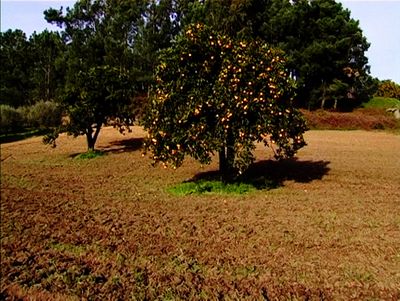Loosely based on Claude Lévi-Strauss and his concept of “wild thought", Raul Domingues' cinematic approach in TERRA QUE MARCA (Striking Land) could be described as “wild sight”. What he proposes resists a rationalizing perception of the world. Instead, our understanding of space and time is questioned so as to establish a different order, a different relationship to our surroundings. In this new order, foliage trembling in the wind replaces plot points, a flash of lightning replaces dramaturgical tension, and the peeling of a freshly picked orange replaces an epiphany. To describe the film, we would in fact need a language different to the one normally encountered around cinema.
TERRA QUE MARCA is built close to the ground. At the base of all things. It is a film about the literal earth upon which we live. Without words, the camera crawls past the mass of roots to the light. Mud, buried seeds, asphalt roads, water channels, plants sprouting forth. A wordless, telluric hymn. TERRA QUE MARCA is sensual ethnography. However, shot as it was in several Portuguese villages north of Leiria, the film is interested neither in the actual work of the farmers nor an idyllic transfiguration of nature. Instead, director Raul Domingues strives to capture on film the perceptions of those who work with the earth.
People move in this film like ants. Tirelessly they toil. They build, plough, sow, water, trample, destroy, build. In a nutshell: they work.
This concerns space and time. Space cannot be thought of in the abstract in TERRA QUE MARCA. Instead, a thoroughly cosmic connection is established between things. Falling trees, splattering manure, bouncing robins, a thunderstorm, blooming flowers. Everything emerges from one another. We perceive these connections more strongly when we live with the earth instead of keeping it at a distance. People move in this film like ants. Tirelessly they toil. They build, plough, sow, water, trample, destroy, build. In a nutshell: they work. And at some point, they eat the produce of their labour.
But the perception of time also changes. A different duration, a different sensibility. In TERRA QUE MARCA there are no clocks or calendars. It is nature that determines time. Cyclically and suddenly. In this respect, the film joins a long line of works concerned with agriculture. FARREBIQUE (1946) by Georges Rouquier, for example, is a film in which time is organised according to the recurring principle of the seasons. Since nature does not know whether today is Monday or Tuesday, those who live with nature must follow this sense of time detached from humans. Most processes of the earth last longer than a film. Thus, to record them, cinema must change.
Like Rouquier, Domingues proposes a kind of cinema that sees the world differently. It is a political proposal. But instead of slogans, it features images and sounds. The camera must react incessantly to what it was unable to anticipate. It no longer controls. It cannot predict a leaf falling from a tree or when lightning will strike amidst the thunder in the sky. The earth cannot be re-potted for the sake of the image. No one can prune a branch to see more. No one can push beautiful flowers into the picture. No, the earth makes the rules and cinema reacts.
What the film wishes to do is travel inside the earth. To make pictures where there is only darkness. There where the last secrets of this planet are buried, to finally learn to respect it.
We live in an age when our relationship to the earth, defined by capitalism, needs to be restructured. TERRA QUE MARCA confronts us with an already existing version of how to live with the earth instead of exploiting it. This is by no means a utopia. This is a work that first of all triggers our attention and then our consciousness. A different consciousness. In recent debates, for instance, we repeatedly read about the negative impact of soil sealing. In TERRA QUE MARCA, we sense that the earth needs to breathe. We see how it demands everything of us, but also that it rewards us too. Thus, a plant cutting grows into a large tree bearing oranges.
What the film wishes to do is travel inside the earth. To make pictures where there is only darkness. And there, where the last secrets of this planet are buried, to finally learn to respect it. To live with the larvae, bacteria, worms, and grubs. At one point, there is dirt on the camera lens. At another, sunlight breaks into a thousand colours. What can cinema learn from the ground beneath us? Under the ground lies the past (layers of time, fossils, bones) as well as the future (everything that will grow, explode, spill out toward the light). The camera can only register the present. But like a gardener—once described by famous landscape architect and author Gilles Clément as someone digging his hands into the earth while looking up to the sky—a filmmaker can work with the past and the present to create the future.
Patrick Holzapfel is an author, filmmaker, and curator. He edits the website “Jugend ohne Film” and is writing his debut novel “Hermelin auf Bänken”.
Translation: Claire Cahm
